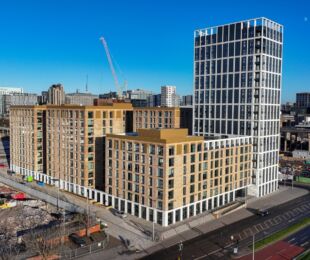

Woodside Press is a new build, 3-bedroom house and studio for a young family in south Bristol, UK. Located within the Bedminster Conservation Area, the constrained site commands a prominent position on a historic street that required a considered and sensitive response to its redevelopment. The design focuses on contemporary material specification and detailing that also respond to and complement the historic character of the area.
The former building, The Old Coach House, was one of the oldest in the area. It pre-dated the surrounding Victorian terraced houses and its unique character represented the more humble beginnings of Southville’s history. After various incarnations, as both an industrial building and stables, the building fell into disrepair and, following years of dereliction, was unable to be refurbished or re-used.
Whilst reflecting the scale and form of the original building, the design of the new house incorporates many key features that made it unique. This includes retaining the original cobbles at the house entrance and using distinctive brick panels to trace the original openings in The Old Coach House facade, namely the stable entrance, shop front and loft storage entrance. These panels are also repeated on the north elevation to mark the historic position of the first storey windows of The Old Coach House, as windows were omitted in the new design to maintain privacy for the occupants and surrounding neighbours.
The brick panels are created using bricks laid and stacked vertically, at 45 degrees to the typical stretcher bond orientation, to create projecting features within the facade. These ridged panels provide a visual link to the original building and add texture and intrigue to the street.
The constrained and historic nature of the site creates geometries that require a non-orthogonal approach at several of the building corners. Here, bespoke cut-and-bonded bricks are used to maintain the consistency of the brickwork coursing, as well as the industrial and textured aesthetic.
The Wienerberger Con Mosso brick specification was crucial to the success of the new building. The brick was required to reflect and nurture the industrial heritage of the site, whilst also responding to neighbouring finishes of render and mixed local stone of the Victorian terraces opposite. The soft tones and varied nature of the Con Mosso bricks perfectly complement the richness of this setting.
Internally, the ground floor level has been lowered, relative to the pavement that borders the southern and eastern edges of the site, to create a generous ceiling height in the main, open plan, living space, with a central bespoke staircase. This level change also facilities an enclosed courtyard, in which the Con Mosso bricks are complemented by a bespoke floor tile design, to become a key focal point of the house.
The house is designed to be low energy in use. Heating and hot water is provided by an air-source heat pump and is mechanically ventilated, with warmth recovered from exhaust air to heat incoming fresh air (MVHR). Fabric performance and airtightness have been optimised to reduce heating demand.







